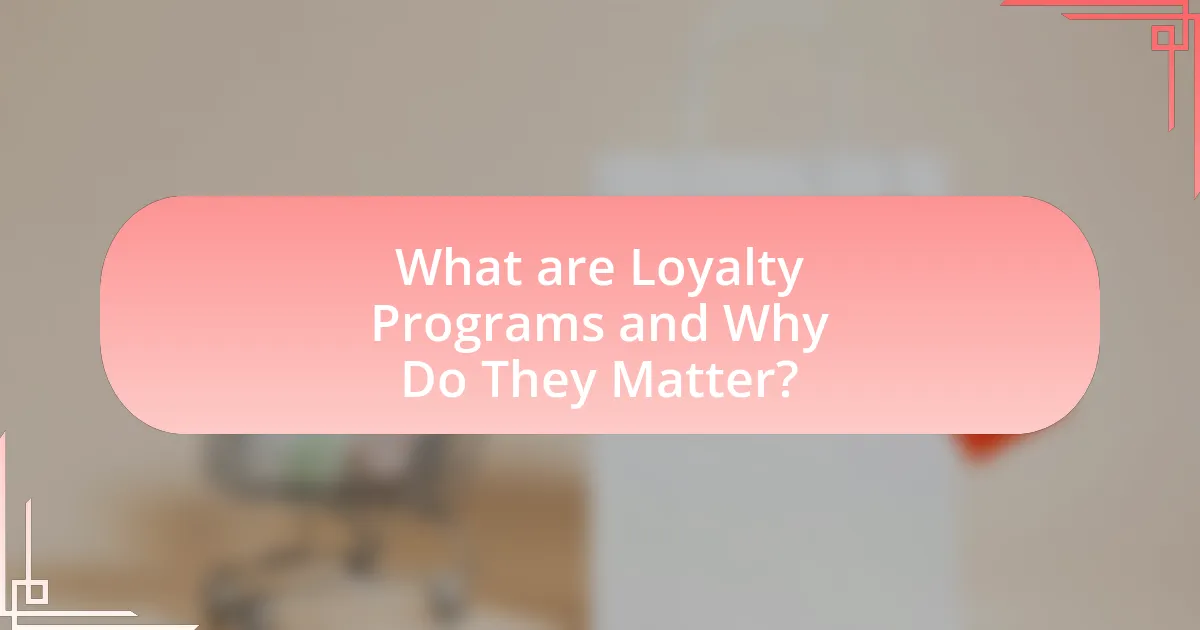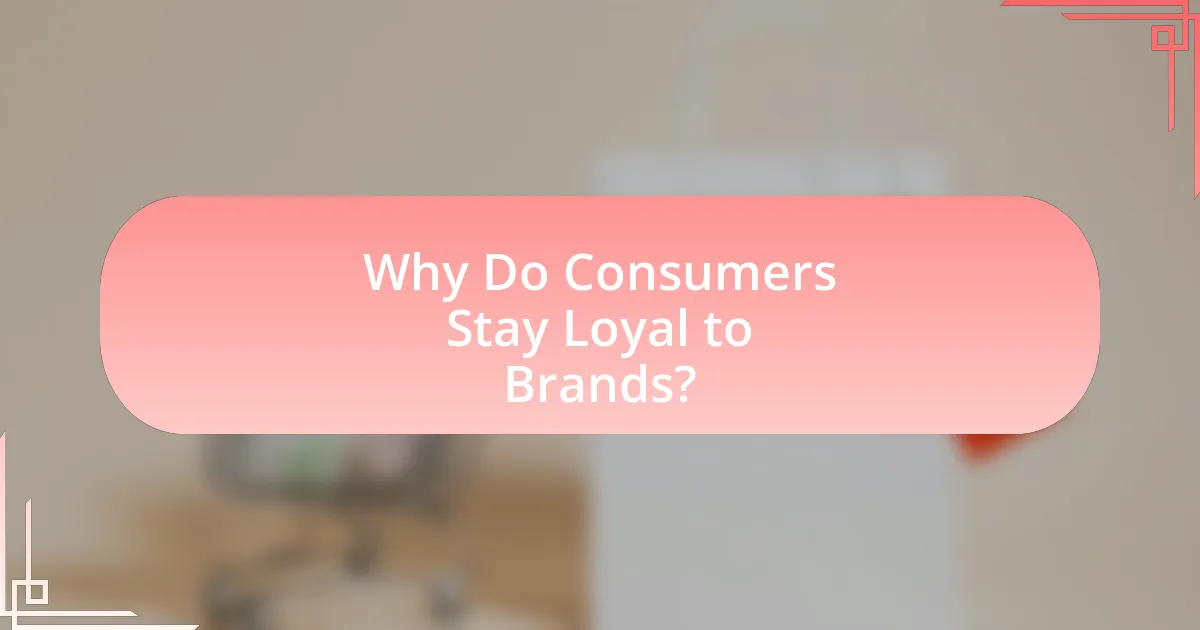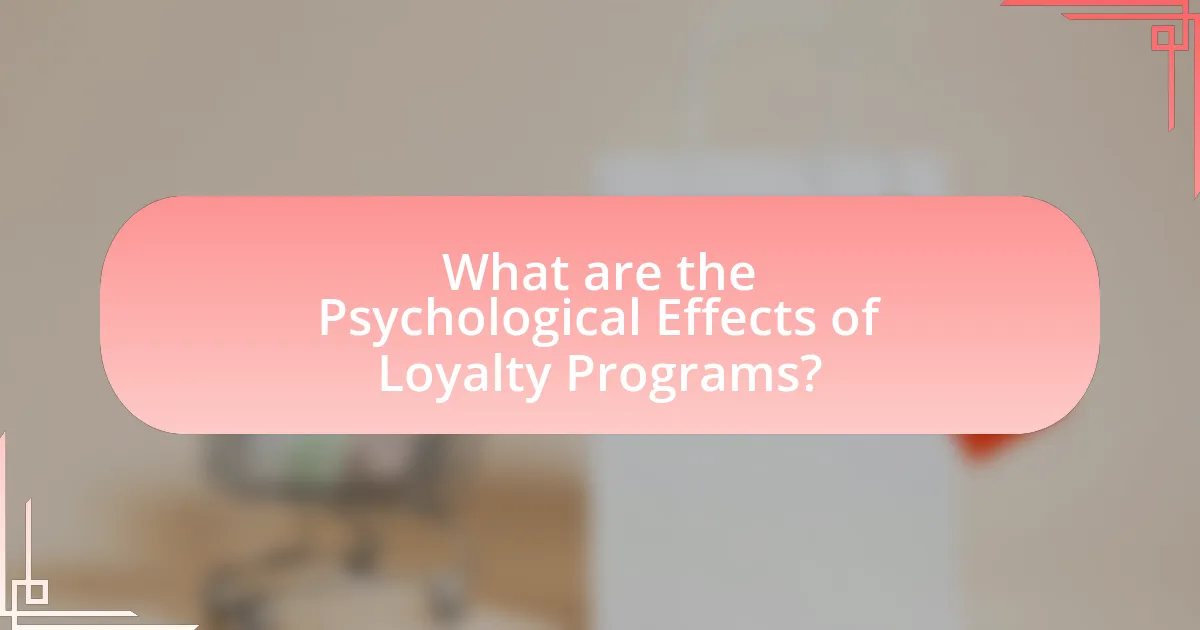Loyalty programs are structured marketing strategies aimed at encouraging repeat business by rewarding customers for their continued patronage. These programs significantly enhance customer retention, increase sales, and foster brand loyalty, with research indicating that members spend 12-18% more than non-members. The article explores how loyalty programs influence consumer behavior through psychological principles such as reciprocity and commitment, and examines the emotional connections they create. It also discusses various types of loyalty programs, their impact on consumer loyalty, and best practices for brands to implement effective loyalty initiatives.

What are Loyalty Programs and Why Do They Matter?
Loyalty programs are structured marketing strategies designed to encourage repeat business by offering rewards to customers for their continued patronage. These programs matter because they enhance customer retention, increase sales, and foster brand loyalty, which is crucial in a competitive marketplace. Research indicates that customers who are part of loyalty programs spend 12-18% more than non-members, demonstrating the financial impact of these initiatives on businesses. Additionally, loyalty programs can improve customer engagement and satisfaction, as they create a sense of belonging and appreciation among consumers.
How do loyalty programs influence consumer behavior?
Loyalty programs significantly influence consumer behavior by incentivizing repeat purchases and fostering brand attachment. These programs create a sense of belonging and reward consumers for their loyalty, which can lead to increased spending. Research indicates that customers enrolled in loyalty programs are 60% more likely to make repeat purchases compared to non-members. Additionally, loyalty programs often utilize tiered rewards, which encourage consumers to spend more to reach higher levels of benefits, further driving sales. This behavioral shift is supported by the psychological principle of reciprocity, where consumers feel compelled to return the favor for the rewards they receive.
What psychological principles underpin loyalty programs?
Loyalty programs are underpinned by several psychological principles, including the principles of reciprocity, commitment, and social proof. The principle of reciprocity suggests that when customers receive rewards or benefits from a brand, they feel compelled to return the favor by making repeat purchases. Commitment is another key principle, as customers who invest time or money into a loyalty program are more likely to continue engaging with the brand to justify their initial commitment. Social proof plays a role as well; when customers see others participating in a loyalty program or benefiting from it, they are more likely to join and remain loyal themselves. These principles are supported by research, such as the study by Cialdini (2009) which highlights how reciprocity influences consumer behavior, and the work of Argo, Dahl, and Manchanda (2005) that demonstrates the impact of social proof on purchasing decisions.
How do loyalty programs create emotional connections with consumers?
Loyalty programs create emotional connections with consumers by fostering a sense of belonging and appreciation. These programs often reward customers for their repeat business, which enhances feelings of value and recognition. For instance, a study by the Harvard Business Review found that customers who feel appreciated are more likely to develop a strong emotional attachment to a brand. This attachment is further reinforced through personalized rewards and experiences, which cater to individual preferences and needs, making consumers feel understood and valued. Additionally, loyalty programs often create community among members, encouraging social interactions that deepen emotional ties to the brand.
What types of loyalty programs exist?
There are several types of loyalty programs that exist, including points-based programs, tiered programs, paid membership programs, and cashback programs. Points-based programs reward customers with points for purchases, which can be redeemed for discounts or products. Tiered programs offer different levels of rewards based on customer spending, incentivizing higher spending for better benefits. Paid membership programs require customers to pay a fee for exclusive perks, while cashback programs provide a percentage of the purchase amount back to the customer. These structures are designed to enhance customer retention and encourage repeat business, as evidenced by studies showing that loyalty programs can increase customer lifetime value by up to 30%.
How do points-based systems work?
Points-based systems operate by allowing consumers to earn points for specific actions, such as purchases, which can later be redeemed for rewards or discounts. These systems incentivize customer loyalty by creating a tangible value exchange; for example, a customer may earn one point for every dollar spent, and once they accumulate a certain number of points, they can redeem them for a reward, such as a free product or service. Research indicates that loyalty programs can increase customer retention by up to 20%, as they encourage repeat purchases and foster a sense of belonging among consumers.
What are tiered loyalty programs and their benefits?
Tiered loyalty programs are structured reward systems that categorize customers into different levels based on their spending or engagement, offering increasingly valuable benefits at each tier. These programs incentivize customers to increase their purchases to reach higher tiers, which can lead to greater customer retention and increased sales for businesses. Research indicates that tiered loyalty programs can enhance customer satisfaction and loyalty by providing personalized rewards, fostering a sense of achievement, and encouraging ongoing engagement with the brand. For example, a study by the Harvard Business Review found that customers in tiered loyalty programs tend to spend more as they strive to attain higher status, demonstrating the effectiveness of this approach in driving consumer behavior.

Why Do Consumers Stay Loyal to Brands?
Consumers stay loyal to brands primarily due to emotional connections, perceived value, and consistent positive experiences. Emotional connections arise when brands resonate with consumers’ identities or values, fostering a sense of belonging. For instance, a study by the Harvard Business Review found that emotionally connected customers are more than twice as valuable as highly satisfied customers, indicating that emotional loyalty significantly impacts brand retention.
Perceived value plays a crucial role as well; when consumers believe they receive superior quality, service, or benefits from a brand, they are more likely to remain loyal. Research from Bain & Company shows that increasing customer retention rates by just 5% can increase profits by 25% to 95%, highlighting the financial benefits of brand loyalty.
Lastly, consistent positive experiences reinforce loyalty, as consumers tend to stick with brands that meet or exceed their expectations. According to a report by PwC, 73% of consumers cite experience as an important factor in their purchasing decisions, further supporting the idea that positive interactions lead to brand loyalty.
What factors contribute to consumer loyalty?
Consumer loyalty is primarily influenced by factors such as trust, customer satisfaction, perceived value, and emotional connection. Trust is established through consistent product quality and reliable service, which encourages repeat purchases. Customer satisfaction arises from positive experiences, leading to a higher likelihood of loyalty. Perceived value, which includes the benefits received relative to the cost, plays a crucial role; consumers are more likely to remain loyal if they feel they are receiving good value for their money. Additionally, emotional connections fostered through personalized experiences and brand engagement can significantly enhance loyalty, as consumers often develop attachments to brands that resonate with their values and identity.
How does perceived value affect loyalty?
Perceived value significantly influences customer loyalty by shaping the customer’s overall satisfaction and emotional connection to a brand. When consumers believe they receive high value from a product or service, they are more likely to remain loyal, as evidenced by a study from the Journal of Retailing, which found that perceived value directly correlates with repeat purchase behavior. This connection occurs because high perceived value enhances customer trust and satisfaction, leading to a stronger commitment to the brand.
What role does customer satisfaction play in loyalty?
Customer satisfaction is a critical driver of customer loyalty, as satisfied customers are more likely to repeat purchases and remain committed to a brand. Research indicates that a 5% increase in customer satisfaction can lead to a 25% increase in loyalty, highlighting the direct correlation between the two. Satisfied customers not only return but also advocate for the brand, influencing others through positive word-of-mouth. This relationship is supported by studies showing that brands with high customer satisfaction scores often enjoy greater market share and profitability, reinforcing the importance of prioritizing customer satisfaction to foster loyalty.
How do loyalty programs enhance customer retention?
Loyalty programs enhance customer retention by incentivizing repeat purchases through rewards and benefits. These programs create a sense of belonging and appreciation among customers, which fosters emotional connections to the brand. Research indicates that businesses with effective loyalty programs can see a retention rate increase of 5% to 10%, significantly impacting profitability, as acquiring new customers is often five to twenty-five times more expensive than retaining existing ones. Additionally, a study by Bain & Company found that loyal customers are worth up to ten times as much as their first purchase, demonstrating the financial benefits of maintaining customer loyalty through structured programs.
What incentives do loyalty programs provide to keep consumers engaged?
Loyalty programs provide incentives such as rewards, discounts, exclusive offers, and personalized experiences to keep consumers engaged. These incentives encourage repeat purchases by creating a sense of value and appreciation for the consumer’s loyalty. For instance, a study by the Loyalty Research Center found that 70% of consumers are more likely to recommend a brand with a good loyalty program, highlighting the effectiveness of these incentives in fostering customer engagement and retention.
How does personalization in loyalty programs impact consumer loyalty?
Personalization in loyalty programs significantly enhances consumer loyalty by creating tailored experiences that resonate with individual preferences and behaviors. When loyalty programs utilize data analytics to customize rewards, communications, and offers, consumers feel more valued and understood, which fosters a stronger emotional connection to the brand. Research indicates that 80% of consumers are more likely to make a purchase when brands offer personalized experiences, demonstrating that personalization directly correlates with increased engagement and repeat purchases. This connection is further supported by a study from Epsilon, which found that 90% of consumers are more likely to shop with brands that provide personalized offers and recommendations, highlighting the effectiveness of personalization in driving consumer loyalty.

What are the Psychological Effects of Loyalty Programs?
Loyalty programs create psychological effects that enhance consumer attachment and repeat purchasing behavior. These programs leverage principles such as the endowment effect, where consumers perceive greater value in rewards they have earned, leading to increased satisfaction and commitment to the brand. Research indicates that loyalty programs can trigger feelings of belonging and community, as consumers often identify with brands that reward their loyalty, fostering emotional connections. Additionally, the anticipation of rewards can activate the brain’s reward system, similar to the effects of gambling, which reinforces the desire to engage with the brand. Studies show that consumers enrolled in loyalty programs are more likely to exhibit brand loyalty, with a report from Bond Brand Loyalty revealing that 79% of consumers are more likely to continue doing business with brands that have loyalty programs.
How do loyalty programs leverage behavioral psychology?
Loyalty programs leverage behavioral psychology by utilizing principles such as reward systems, social proof, and commitment to influence consumer behavior. These programs often implement tiered rewards, which create a sense of achievement and motivate customers to engage more frequently to reach higher levels. For instance, a study published in the Journal of Marketing Research found that consumers are more likely to increase their spending when they perceive they are close to achieving a reward threshold. Additionally, loyalty programs often incorporate social proof by showcasing how many others are participating, which can enhance a sense of belonging and encourage continued patronage. Furthermore, the commitment principle suggests that once consumers enroll in a loyalty program, they are more likely to remain loyal to the brand due to the psychological investment they have made.
What is the impact of rewards on consumer motivation?
Rewards significantly enhance consumer motivation by providing tangible incentives that encourage repeat purchases and brand loyalty. Research indicates that consumers are more likely to engage with brands that offer rewards, as these incentives create a sense of value and appreciation. For instance, a study published in the Journal of Marketing Research found that loyalty programs can increase customer retention rates by up to 20%, demonstrating the effectiveness of rewards in motivating consumer behavior. Additionally, rewards can trigger positive emotions, reinforcing the consumer’s connection to the brand and leading to increased spending.
How does the concept of loss aversion apply to loyalty programs?
Loss aversion applies to loyalty programs by leveraging consumers’ tendency to prefer avoiding losses over acquiring equivalent gains. This psychological principle suggests that customers are more motivated to maintain their loyalty status and avoid losing benefits, such as points or rewards, than they are to seek new rewards. For instance, a study by Kahneman and Tversky highlights that the pain of losing is psychologically more impactful than the pleasure of gaining, which loyalty programs capitalize on by creating tiered rewards systems. These systems encourage customers to stay engaged to avoid losing their accumulated benefits, thus enhancing retention rates and customer loyalty.
What are the long-term effects of loyalty programs on consumer behavior?
Loyalty programs have significant long-term effects on consumer behavior, primarily by fostering repeat purchases and enhancing brand loyalty. Research indicates that consumers enrolled in loyalty programs are 60-70% more likely to return to a brand compared to non-members. This increased retention is often attributed to the perceived value and rewards associated with the program, which create a sense of belonging and commitment to the brand. Additionally, loyalty programs can lead to higher customer lifetime value, as members tend to spend more over time; for instance, a study by the Harvard Business Review found that loyal customers are worth up to ten times as much as their first purchase. Overall, loyalty programs effectively shape consumer behavior by encouraging ongoing engagement and deeper emotional connections with brands.
How do loyalty programs influence repeat purchasing habits?
Loyalty programs significantly influence repeat purchasing habits by incentivizing customers to return for additional purchases through rewards and benefits. These programs create a sense of belonging and value, encouraging consumers to choose a brand consistently over competitors. Research indicates that 70% of consumers are more likely to recommend a brand with a good loyalty program, highlighting the effectiveness of these initiatives in fostering customer retention. Additionally, a study by Bond Brand Loyalty found that members of loyalty programs are 80% more likely to make repeat purchases compared to non-members, demonstrating the direct correlation between loyalty incentives and increased buying frequency.
What is the relationship between loyalty programs and brand advocacy?
Loyalty programs directly enhance brand advocacy by incentivizing repeat purchases and fostering emotional connections with consumers. These programs reward customers for their loyalty, which increases their satisfaction and likelihood of recommending the brand to others. Research indicates that 77% of consumers are more likely to recommend a brand with a good loyalty program, demonstrating a clear link between loyalty initiatives and positive word-of-mouth. This relationship is further supported by the fact that engaged customers are 60% more likely to advocate for a brand, showcasing how loyalty programs can transform satisfied customers into brand advocates.
What best practices can brands implement in their loyalty programs?
Brands can implement several best practices in their loyalty programs to enhance customer retention and engagement. First, offering personalized rewards based on customer preferences and purchase history can significantly increase program effectiveness; studies show that 80% of consumers are more likely to engage with brands that offer personalized experiences. Additionally, creating tiered loyalty levels encourages customers to spend more to reach higher tiers, which has been shown to boost customer lifetime value. Furthermore, integrating omnichannel experiences allows customers to earn and redeem rewards seamlessly across various platforms, enhancing convenience and satisfaction. Lastly, regularly communicating with members through targeted promotions and updates keeps the program top-of-mind, fostering a sense of community and belonging.
How can brands effectively measure the success of their loyalty programs?
Brands can effectively measure the success of their loyalty programs by analyzing key performance indicators (KPIs) such as customer retention rate, average transaction value, and program participation rates. For instance, a study by the Loyalty Research Center found that companies with effective loyalty programs see a 5-10% increase in customer retention, which directly correlates with increased revenue. Additionally, tracking the frequency of repeat purchases and the overall lifetime value of customers who engage with the loyalty program provides concrete data on its effectiveness. By utilizing these metrics, brands can gain insights into customer behavior and make informed adjustments to enhance their loyalty initiatives.
What strategies can enhance the effectiveness of loyalty programs?
To enhance the effectiveness of loyalty programs, businesses should implement personalized rewards, tiered benefits, and seamless integration across channels. Personalized rewards, which cater to individual customer preferences, can increase engagement; for instance, a study by McKinsey found that personalization can lead to a 10-30% increase in revenue. Tiered benefits create a sense of achievement and encourage customers to spend more to reach higher levels, as evidenced by the success of programs like Starbucks Rewards, which saw a 25% increase in customer spending after introducing tiered levels. Lastly, seamless integration across online and offline channels ensures a consistent customer experience, which is crucial; research from Harvard Business Review indicates that customers who engage with multiple channels spend 10% more in-store than single-channel customers.


